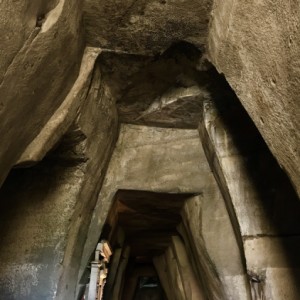San Gennaro takes a selfie
Napoli. Day Seven
Naples is an archaeolical layer-cake and we spent much of our last full day here going underground (I get points from WonderA for referencing Paul Weller, who she adores)
First, to San Lorenzo Maggiore, a humble 13thC church built on top of the remains of a Greco-Roman shopping street. Below the cloisters, handsome, precise brick and stone buildings line narrow streets that haven't known bustle or sunlight for aeons. It was a joy to get back to now and feel that same long-missed warmth on our necks.
After a late lunch of fishy pasta, haphazardly served by a slightly tipsy Mamma, we headed off to find the Cimetero delle Fontanelle, an ancient ad-hoc burial ground carved into a hillside in the badlands of Sanità, a northern suburb of the city.
We both had mixed feelings about this plan...it could be gruesome and Sanità is down in the guidebooks as a no-go area in the evening...wonderfully it turned out to be one of the most gratifying experiences of our adventure.
Firstly, we had just set foot in what was a rather dilapidated street of houses and workshops, when we were set upon by a gang of women, all in black, who were sitting on the steps of the local church.
They had seen WonderA's camera and insisted on having their photograph taken
...a joyful encounter (see WFT's journal entry for the day)
Secondly, the cemetery itself. A Futurist's Cathedral quarried out of volcanic stone for centuries and now home to the mortal remains of millions of unfortunate Neopolitans.
The story of the cemetery (more accurately ossuary) is a raw litany of corruption, serial devastation and unswaying respect for family, faith and food - the soundtrack to the story of Napoli itself.
I have never seen anything like it, it shook me up and inspired me. Immense, wide vaulted aisles lined on each side by walls of carefully stacked bones dissapearing into the gloom. Following ancient rules of dry stone walling, clavicle and pelvic bones formed a foundation on which long bones in their thousands were stacked tightly, creating straight stable walls topped finial-like, by proud skulls.
Many bodies creating one body.
Some estimates claim that many millions of bodies were discarded in this quarry, thrown away, ignored until in 1872 a local priest urged the congregation to follow his lead and invest dignity and love into this morass on their doorstep.
For almost a century local families laboured on this monument to their anonymous ancestors. I imagine they gained comfort in believing that their love given would be returned in time.
Fifty years ago this remarkable memorial was reopened for all to see....
PS Extras show the GrecoRoman Street and two images of the cemetery. These last two could be seen as upsetting, but I wanted to show the scale of the place. Please open with care




Comments
Sign in or get an account to comment.


